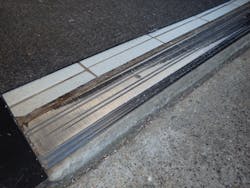If you happen to walk through a commercial-door opening and the door slams or doesn’t close, your chance to replace that closer is close at hand. Give the proprietor your card and tactfully joke that a lawsuit by someone getting their fingers slammed in the door is way more expensive than replacing the closer.
You might not be able to replace every bad door closer that you come across, but many are fairly easy to replace. Removing a storefront door typically is a one-person job, and replacing a concealed overhead closer can be as easy as removing two nuts and two large Phillips-head screws.
This particular storefront door at a laundromat is used hundreds of times each day. The door was sagging, and the closer no longer held the door in the open position. These closers can be ordered two ways — either the door closes all the time or, when pushed open past 90 degrees, the door holds open until someone pulls the door closed again. For people carrying loads of laundry, it’s easier if the doors have a hold-open position. For servicing, the door is more easily removed in the hold-open position.
Doing the Work
Most commercial doors are attached to the concealed overhead closer by a bracket held on by three hex screws. (Image 2) New closers come with a new bracket and screws, but unless you’re replacing the end-load arm on top of the door, you might have to use the old bracket with new screws.
After the mounting block is removed, push the door away from the closer shaft. (Image 3) Careful! This is when the door can get away from you. Slide the door away from the closer, then lift the door off the bottom pivot.
Now is a good time to grease the bottom pivot and check the bottom pivot bracket on the lower edge of the door. Insert a standard screwdriver through a hole along the back bottom edge of the door and note how the bottom pivot can be raised slightly or lowered by turning the screwdriver one way or the other.
The closer is concealed (hence the name) above a flat aluminum plate along the door header. Remove the plate by prying along one edge with a screwdriver. (Image 4) The plate snaps back into place. Remember to reinstall the plate before you remount the door!
Also, scribe into the plate a “C” and an “L” for closer and latch-speed adjustment, because after the plate is reinstalled, you normally can’t see which is which (although the latch-speed adjustment is toward the latch side of the door). (Image 5)
After the closer has been replaced, take a crescent wrench and turn the closer shaft back to the hold-open position, then reinstall the door.
Besides replacing a missing screw on the mounting plate that sits on the bottom door pivot, this door had “issues” with the top end-load arm (the arm that connects the closer to the door). It’s common for the main Phillips screw to become stripped where the arm attaches to the door.
We drilled and tapped for another extra-large Phillips screw to attach the end-load arm securely to the door. (Image 6) Although this prevents the door from being adjusted inward or outward slightly, it also will keep the door from sagging. I keep telling the proprietors that the three doors leading into the laundromat should be replaced, but as long as I can fix them — even temporarily — they won’t do it.
Michael C. Tritel is the owner of Lively Locks & Deadbolts in Meadow Vista, California.
